An activity guide for your baby’s first year
Each month in your baby’s first year brings new surprises, from their first smile to their first steps. As your little one grows, their developmental needs evolve, and that’s when finding fun activities to nurture their growth becomes essential: What excites them in month two might feel like old hat once month six rolls around. Play is not just a form of entertainment for your child—it has a vital role in their overall development and learning, from building confidence to understanding how the world works to strengthening your parent-child bond.
Whether you’re looking for sensory play experiences, interactive games or open-ended play activities to nurture their emerging skills, we’ve curated an array of activities and fun things to do with baby tailored to each month of your child’s growth.
Why is play important for babies?
Play is crucial for babies as it supports their cognitive, sensory, motor, social, emotional, and language development. It promotes a holistic approach to learning, allowing babies to explore, discover, and make sense of the world around them while having fun.
Put simply, babies and young children learn primarily through play. When babies play, it helps them practice and strengthen their executive functioning skills, which will support their learning throughout their lives. Resilience, self-control and attention are key areas that play can help develop, too.
What are developmental play activities?
Developmental play activities directly support progress on developmental milestone skills, such as gaining head and neck control, making sounds to communicate, and grasping objects, just to name a few. Tummy time is a good example of a developmental activity that focuses on providing opportunities for babies to practice and refine specific skills while promoting overall growth.
Later in your child’s first year, you might create an indoor obstacle course for them to crawl through, set up a ball rolling game or help them brush their doll’s teeth. Developmental activities tend to help babies develop motor skills, communication and cognitive thinking, as well as social and emotional growth.
What is sensory play?
There’s some overlap between developmental and sensory play, as sensory play activities can also contribute to developmental milestones. But essentially, sensory play is a type of play that engages one or more of a child’s senses. It’s usually focused on the sense of touch, like playing with playdough or using a water table, but even listening to music and painting can be forms of sensory play.
The benefits of sensory play are wide-reaching, from encouraging language and communication to supporting critical thinking skills. By providing experiences that engage your little one’s senses and support their cognitive, physical, and social growth, sensory play helps your child integrate sensory inputs and build more nerve connections in the brain. You might point out the colors of the leaves to your 4-month-old, sing “B-I-N-G-O” with your 7-month-old, or let your 11-month-old experiment with (washable) finger paint. All are examples of sensory play.
Baby activities by month
1-month-old activities
Your little love is still brand new, and is working on getting used to the world around them. You’re their guide—and favorite teacher. Focus on giving them lots of loving attention and snuggles and responding to their needs—that’s all the activity newborns really need in month one, but if you want to make the most of those short wake windows, try out the following.
-
Have a chat: Talk with baby about the things you’re doing daily, like making tea, going for a walk and looking at the trees; even diaper changes seem interesting to them if you’re telling them all about it, mama.
-
Copycat: Try making fun facial expressions for your baby to imitate, like wrinkling up your nose, sticking out your tongue and smiling. Can they copy you?
-
Tummy time: Try laying baby tummy-down across your lap while seated, so they’ll know you’re right there with them. Progress to a fun play mat with graphic, black and white toys or books to flip through.
Things to do with baby at 1 month
Infant massage can improve parent-infant interactions, reduce crying and relieve stress. Plus, a bedtime massage can promote relaxation and sleep, so you might score a few extra winks, too.
2-month-old activities
You’re getting to know your baby more, and they’re learning more about you, too. Further that bonding and secure attachment with activities that promote connection and communication.
-
Sing a song: Singing sweet songs and lullabies throughout your day, whether you’re cooking, driving, washing up, or getting ready for bed—your little one will benefit from the introduction of music and rhythm—and hearing your voice.
-
Stretch it out: Encourage your baby to stretch out their body after being in the womb by helping them reach their arms out wide and bringing their hands together to clap. Help create movement in their lower body by gently moving their legs like they’re pedaling a bicycle.
-
Reading time: Instilling an early love of reading can strengthen language skills and parent-child relationships, an activity that will deepen your tot’s love of books and promote mama-baby bonding.
Things to do with baby at 2 months
Keeping your infant close by babywearing during the day can help promote comfort and reduce crying. Try babywearing while you do other chores or take care of other kids—or while you go for a stroll outside. We’re betting baby will sleep super soundly if worn for naps—and will love getting in some extra skin-to-skin contact, too.
3-month-old activities
Your baby is more awake and alert during the day (which hopefully means longer stretches of sleep at night). That also means you’ve got more time in between feedings and naps to try out a few fun activities together.
-
Play back and forth: If they smile at you, you smile back. If they coo, make the same sound back. Keeping this sensory game going helps lay the foundation for emotional development and receptive language as well as cause and effect down the line.
-
Tummy time 2.0: Is your baby ready to level up on tummy time? Encourage them to keep building up strength by placing a toy nearby that’s *just* out of reach. Will they push up to grab it?
-
Name it: Start building their vocabulary by pointing to their body parts and naming them, and then helping them move them around: “See this? That’s your elbow! Look how it bends.”
Things to do with baby at 3 months
Time outside with your babe can provide bonding opportunities and promote physical and mental health. Get some fresh air with a daily walk in the stroller or babywearing carrier. On your jaunts, keep conversation flowing and focus on labeling what you see to build their vocabulary.
4-month-old activities
At 4 months, your little one may start rolling, putting everything in their mouth and playing that fun “game” of throwing toys onto the floor for you to pick up at least 36 times. Here are a few more constructive ideas…
-
Baby chef: Give your baby safe objects from the kitchen to explore that aren’t toys, like a wooden spoon, or a silicone container to hold, mouth and look at.
-
In the mirror: Babies love to see themselves! They’ll smile and even laugh as you point out the baby in the mirror (they don’t yet know it’s their own reflection).
-
Get rolling: Exercise baby’s sense of hand-eye coordination by helping them roll a ball across the room. They may not be able to fully participate in a game of catch just yet, but they’ll be amazed just by watching the action.
Things to do with baby at 4 months
Turn up the tunes (pop on your favorite playlist, mama, so you can really get into it) and have a dance party. Gently twirling around while safely carrying baby or babywearing is a thrilling way for them to develop muscle tone, rhythm foundations and spatial awareness.
5-month-old activities
Your bubbly 5-month-old is working on refining the skills they’ve learned so far to get ready for sitting up and starting solid foods. Keep up the progress with some fresh ways to play.
-
Toy hide-and-seek: This miniature version of the game hide-and-seek is sure to delight: Hide a small toy or lovey under a baby blanket, with just one edge peeking out. Ask your baby to find the toy, and when they do, hide it again elsewhere.
-
Magic box: Fill an empty tissue box with a few small baby-safe objects, like silk play scarves, that they can pull in and out easily—furthering their fine motor skills and grasp of object permanence.
-
Bubble up: Whether you opt for bubble-blowing indoors or out, watch as your little one keeps their focus on the floating bubble (great for eyesight tracking) and reaches out to touch or pop them. Talk about the size of the bubbles to help encourage their visual discrimination skills.
Things to do with baby at 5 months
Incorporating a few baby sign language signs can be super useful in helping your little one learn to communicate before they can really speak. Model the signs for milk, more, mama and others that might prove necessary in your daily routines.
6-month-old activities
Your growing lovebug is working on lots of new skills this month: eating (and playing with) solid foods, sitting unassisted and making new sounds.
-
Stacking blocks: Baby will love helping you create a tower of blocks and then immediately knocking it down. Look for a set of soft blocks that are perfect for little hands to grab.
-
Play peek-a-boo: Try putting your hands over your face and ask, “Where’s Mama?” then remove them. This game helps your baby learn that you go bye-bye, but then you come back. Plus, it’s just so fun!
-
Play with food: Ready to start solids? Aside from eating new things, experiencing how it feels is another way of learning. Babies can explore colors, textures and smells all through the foods they eat. Playing with food is an important part of their sensory development.
Things to do with baby at 6 months
If baby can sit independently, this week may be the perfect time to start bath time in the big tub. Bath time as an evening routine (with soap every other night) is a fun opportunity for you or your partner to bond with your growing kiddo. A bath before bedtime can improve sleep and offers an environment to sing songs and teach concepts like “sink or float” and “wet or dry.”
7-month-old activities
Your 7-month-old is eager to be on the move, making now a good time to start babyproofing. You may find yourself regularly impressed with your baby’s new abilities—and at how much they love to play.
-
Indoor playground: Can you make a mini obstacle course out of cushions for your baby to scoot around in? Your little will love sending balls or cars down a couch cushion ramp or knocking over stacks of pillows with their hands and feet.
-
Face it: Baby is big on faces these days, and we’re betting spotting a few of their faves will bring them joy. Break out the photo albums and point to familiar faces to name each person.
-
Clap to it: Listening to your favorite movie soundtracks (“Moana” or “Encanto”, anyone?) can provide plenty of opportunities for clapping along to the music. Your little one may soon start trying to mimic your claps!
Things to do with baby at 7 months
Parent-child baby classes are a great way to bond with your little one while also building their socialization skills. Now that they’re able to sit up without support, can you help them play an instrument at a baby music class or participate in library storytime? You both might start to look forward to your new weekly routine.
8-month-old activities
There’s a lot happening these days, from scooting (or crawling!) to the start of some separation anxiety. Helping your tot ease into transitions with other caregivers when you leave can go a long way. Once they begin to feel more comfortable, they’ll start to play again.
-
No-mess art: Encourage baby’s burgeoning art skills by placing a piece of paper inside a reclosable plastic bag and adding a few squirts of finger paint inside. With the bag closed, demonstrate how to use your fingers to move the paint around inside the bag and blend it together to cover the paper.
-
Point and tell: Whether you’re reading a book together, taking a walk or shopping for groceries, make a point to point out what you’re noticing for your curious kid, then tell them all about it.
-
Mini maze: Set up a living room maze with pillows and cushions—then have them follow you through it for a cute take on ‘Follow the Leader’ that also boosts their scooting/crawling capabilities.
Things to do with baby at 8 months
Your little one can begin (or continue) playing independently at this stage, too—you don’t need to be cruise director for your tiny tot. Try to involve baby in your day when possible, but know it’s also completely OK to do something just for you while they safely play nearby.
9-month-old activities
Your 9-month-old is working on communicating in lots of new ways. You might see them lift their arms when they want to be picked up, protesting when you leave and happily clapping to get your attention.
-
Name it: When baby gets excited or points to something, talk about it to put words to their gestures, “Yes, that’s a bird!” It also makes them feel good that you understand what they mean.
-
Flour power: In a mess-proof spot, set baby down on the floor with a baking sheet and a few measuring cups full of flour. Let them explore the texture and engage in the act of pouring the flour from one cup to another. Can they make a mountain or a valley?
-
Treasure hunt: Head outdoors with your little one to discover some natural treasures, like bumpy pinecones, fluffy dandelions and smooth stones.
Things to do with baby at 9 months
Find a spot to people-watch with your budding socialite. Point out kids and babies, note different relationships such as family and friends, and observe social behaviors like laughing and talking. Now that baby has a few words and can follow your gaze, you have a perfect coffee date.
10-month-old activities
Your busy bub is working on perfecting their pincer grasp and pulling up to stand this month. Encourage their new skills by working on activities that support both fine and gross motor skills.
-
Tunnel vision: A large, empty cardboard box that’s open on both ends can be the start of a fun tunnel for baby to crawl through. Consider getting baby’s help drawing on the outside to decorate it. Is it a spaceship? A boat? A castle?
-
Mini masterpiece: You might have to sacrifice a pack of Post-Its for this purpose, but the endless entertainment—and hand-eye coordination practice—is worth it. Spread out several sticky notes on the floor or wall of baby’s room, and show them how they can unstick and stick back on, just like magic.
-
Teddy picnic: Pack a few of baby’s favorite on-the-go foods, a blanket, and a basket of baby’s stuffed pals and head to the park. Invite a few real-life friends and make it a day to remember.
Things to do with baby at 10 months
It’s an exciting stage: baby will soon begin engaging in imaginary play. You can get in on the “make-believe” too: Pretend to chat on the telephone (TV remotes and bananas make fab phones!). Feed pretend veggies to your tot’s teddy bear. Act as if you’re an airplane zooming through the air or a train chugging along the tracks.
11-month-old activities
Your busy bee is building strength and coordination and balance, all in preparation to take those first tentative steps. Keep supporting them and encouraging their progress—you’re their favorite cheerleader, mama.
-
Splash zone: Bath time can be playtime, too. With a set of colorful stacking cups and other bright bath toys, encourage your babe to help sort the cups and toys by color and pour water from one object to another.
-
Read aloud: Set up a few favorite stuffies for a storytime session with your baby in an example of dramatic play. Is lion getting a little rowdy? Did baby bunny fall asleep? Help your tot keep everyone in line.
-
Playground date: Your little one loves to people-watch at this age, especially peers and older kids, and might get a kick out of tossing around a ball or trying out the baby swings on a park playground with a fellow tot or toddler.
Things to do with baby at 11 months
At 11 months, moving and grooving is your baby’s favorite thing to do, so why not lean in with a dance party? Help your little one spin and sway to a few fun songs—and be sure to pick your faves too, mama. Watch as they try to mimic your movements.
12-month-old activities
Congrats, mama, your baby is 1! Your newly minted toddler is busy these days—working on walking, talking and taking in everything around them—but be sure to take some time for yourself to reflect on the milestones you’ve reached, right alongside your little one.
-
Color world: Have you broken out the crayons yet? Your tot is finally at the age where they might use them to actually color rather than just chew on them. Help your them scribble and make lines on the page, while naming the colors and creating fun artwork.
-
Bubble party: Bubble play offers a whole new level of fun now that your little one is a bit more mobile. Show them how to purse their lips and blow air through the wand, and help them experience the tactile joy of popping those pretty orbs.
-
Sticker story: They might need help peeling off the sticker from its backing, but they’ll love sticking their favorite colorful characters on a piece of paper or other surface. You could even use their newfound sticker talents to make a few cards for birthdays and holidays, signed with love.
Things to do with baby at 12 months
Fill a small box or basket with a few hats, scarves, sunglasses or other clothing items and accessories you rarely wear to serve as a dress-up bin for your baby. A costume element can help you both get in the mood to play pretend and use your imagination—which baby is just learning how to do!
Our favorite developmental toys for baby’s first year
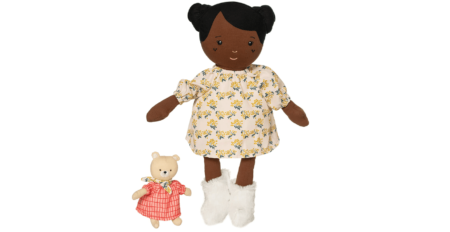
Manhattan Toy
• $23.97
We love these soft little plush doll friends that clean up well—they’re fully machine-washable and dryer-safe, meaning your little one can tote their new pal along anywhere and everywhere.
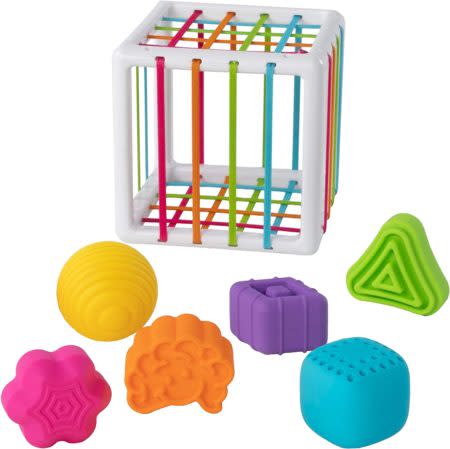
Fat Brain Toys
• $26.95
Geared toward the littlest learners, this toy provides a frustration-free way to explore shapes and textures. Unlike traditional shape-sorting toys, there’s no right or wrong way to get the shapes inside. Instead, they can push the shapes through the elastic bands then explore and experiment ways to get them back out.
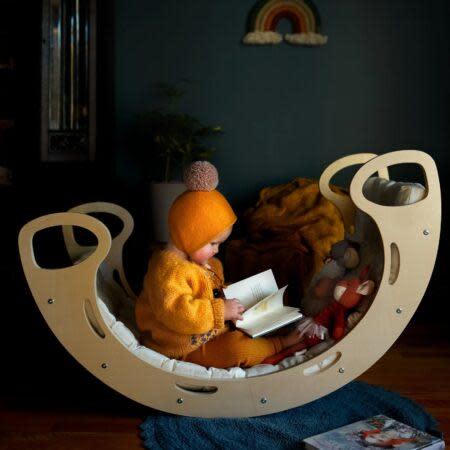
Cassarokids
• $325
It’s safe to say we’re a bit obsessed with the stunning grow-with-me rockers from Cassarokids. At once a place to play, relax and imagine, they can be used from babyhood all the way through childhood. When used as a rocker they can be outfitted with one of Cassarokids’ gorgeous tufted pillows to become the coziest place to read or snooze. Flip it over and it’s a super fun play structure that can support up to 200 pounds! Prices start at $325.
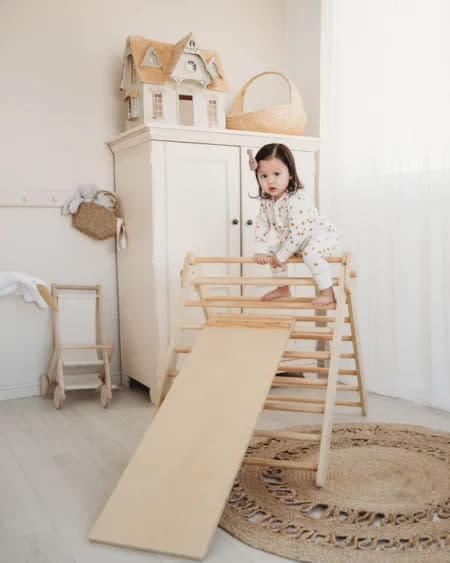
Piccalio
• $349
Pikler triangles are a staple in Montessori classrooms and have subsequently gained popularity at home as well. Developed as a tool to help improve motor development skills, to forge independent activity, and to allow freedom of movement, they’re endlessly entertaining for new climbers, toddlers and bigger kids alike. This foldable version comes with detachable ramp that features a rock climbing wall on one side and a flat surface for sliding on the other.
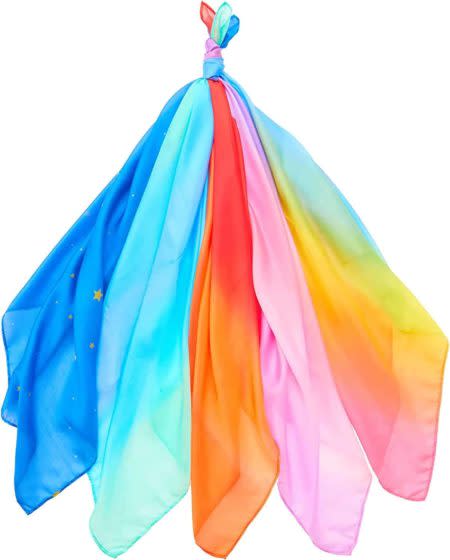
Sarah’s Silks
• $48
Play silks are a perfect vehicle for open-ended play—and one that your kiddo will keep coming back to. Turn them into flags when exploring new lands, a cape for saving the day or a quick cover for a simple game of peek-a-boo. These Montessori faves are costly upfront, but so worth the price.
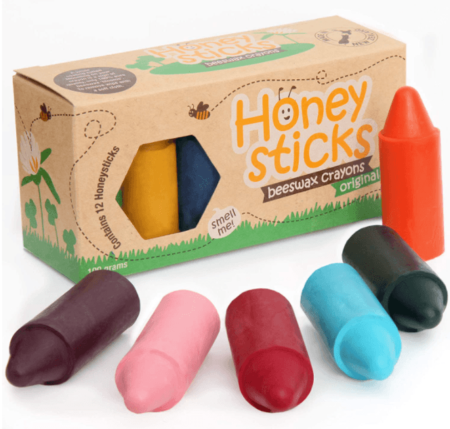
Honeysticks
• $22.95
Little hands will love coloring with Honeysticks, which are big enough to get a whole palm around and smell like honey. The non-toxic beeswax formula will mean you can rest easy if they end up getting gnawed on, mama.